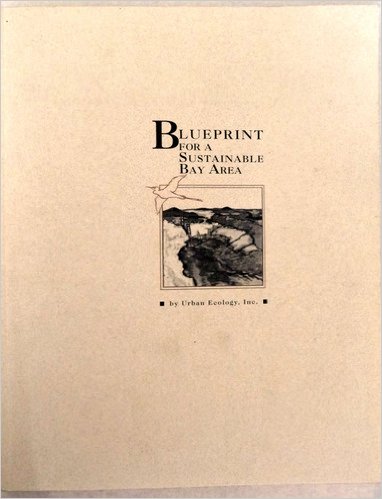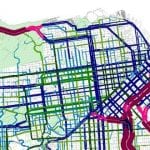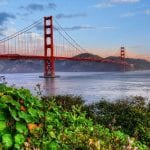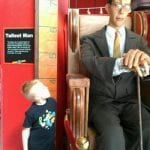by Wood Turner
Urban Ecology’s Blueprint for a Sustainable Bay Area spells out the organization’s vision of how the San Francisco Bay Area can become a better place to live for all its residents. It is the result of a thoughtful and tireless process intended to develop that vision in the most participatory, iterative, and informed manner possible. The process behind the Blueprint is what makes it such a unique and valuable resource.
The first order of business for UE was to convene a Blueprint Management Team, composed of board members and staff, charged with shepherding the process to completion. This committee met regularly throughout the process to discuss the progress of the project, and in early 1995 hired Marcia McNally as director of the Blueprint Project.
The team kicked off the process by establishing seven principles upon which it believed the organization’s vision should be based. Choice, Conservation, Context, Community, Accessibility, Nature, and Justice became both the framework and the inspiration for the effort. Determined to leave no stone unturned, project staff immersed itself in books, articles, studies, Internet discussions, and research to come to a more complete understanding of the issues and development pressures facing the Bay Area as it moves toward the twenty-first century. The staff also interviewed acknowledged experts on various specific topics. The aim throughout was to define issues, stimulate debate, engage potential partners, and form new networks interested in sustainability.
The next phase of the project — the Vision Forum process — was designed to encourage and facilitate participation from the UE membership and the Bay Area community at large. The Vision Forums provided an opportunity for a wide variety of people to participate in informed discussions on Blueprint topics. An extensive series of tours of Bay Area sites illustrating various aspects of sustainable development complemented the forums.
Held on Saturdays during the summer of 1995, Vision Forums on the Home; the Neighborhood; Transportation, Land Use & Who Pays; the Greenbelt and Estuary; Jobs and Industry; Energy, Materials & Water; and Tools and Actions each featured a panel of speakers asked to talk about sustainability issues that concerned them. Forum attendees then broke into groups of six to eight to work on planning and design problems in a standard charrette format. Group leaders led participants through step-by-step exercises designed to stimulate discussion and provide a better sense of the complexity of sustainability issues at the home, neighborhood, and regional scales. At the end of each day-long forum, all groups came together to present ideas, conceptual sketches, problems, and solutions for particular sites and issues. Results of the Vision Forums were carefully recorded and integrated into the outline and text of the Blueprint.
Perhaps the part of the process most designed to guarantee that the Blueprint fit into the context of the Bay Area was the creation of a focus group. This panel, comprised of people of different ethnic, economic, age, and occupational backgrounds from all over the Bay Area, met periodically to look at emerging ideas from a lay perspective. Focus Group members were very engaged in the discussions and very direct with their answers and comments. They were instrumental in challenging the viability of some ideas and inspired staff and the Blueprint Management Team to think more creatively in a number of areas.
As the Blueprint entered the writing stage, a cadre of reviewers provided thoughtful and challenging feedback at several stages. Project staff worked to reconcile hundreds of sometimes conflicting comments and suggestions into a single coherent whole.
And what was the upshot of this multi-layered, time-consuming, and involved process? Urban Ecology’s Blueprint for a Sustainable Bay Area is an attractively-illustrated, book-length document that outlines a vision for the Bay Area’s future. It is designed to educate, invigorate, and create a sense of hope that sustainability can result from a combination of dedicated individual action and wise regional decision-making and coordination.
Throughout the process of developing the Blueprint, Urban Ecology worked hard to establish a model for how that vision can be achieved. The participation of hundreds of individuals and organizations was crucial. Thanks to all of you who played such a tremendous part.
Wood Turner was the researcher for the Blueprint for a Sustainable Bay Area Project, and is pursuing a graduate degree in urban planning at the University of Washington in Seattle.







